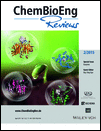Minireview: A Comeback of Hg-Derivatives in Protein Crystallography with Cys-Modification
Abstract
While a majority of protein crystal structures are solved by using molecular replacement (MR), it is limited by the available homologous models with sufficient sequence identity. Another popular method is multi-wavelength anomalous diffraction (MAD) that uses Se-Met and synchrotron radiations. However, proteins containing Se-Met are sometimes difficult to obtain and/or crystallize. Consequently, other heavy-atom derivatives are still used in crystal structure determination, while single isomorphous replacement (SIR) and single wavelength anomalous diffraction (SAD) are more popular than conventional multiple isomorphous replacement (MIR). Here, some recent cases of structure determination in which Hg serves as the only heavy-atom type are discussed. For Hg-derivatives, data collection does not need absorption spectrum scanning and it can be carried out using an in-house X-ray source. Derivatization with Hg can start directly by soaking the native crystals in Hg-containing solutions, or use a specific mutant in the active site of an enzyme if it lacks intrinsic free cysteine residues. The rapid advance of bioinformatics and protein engineering has made this strategy of cysteine-dependent Hg-phasing by MIR, SIR and SAD an effective method of choice besides MR and MAD for crystal structure determination.




